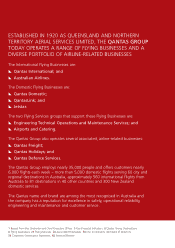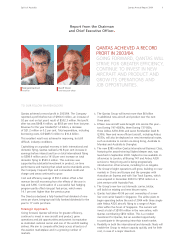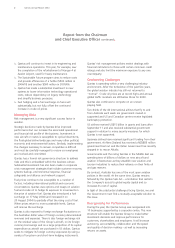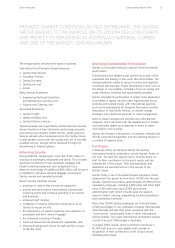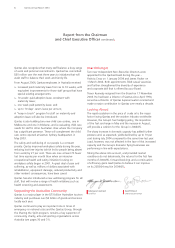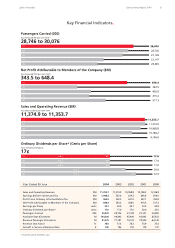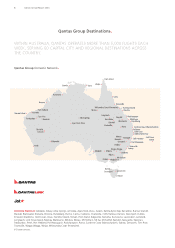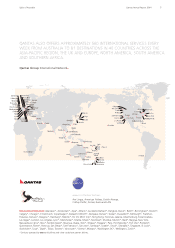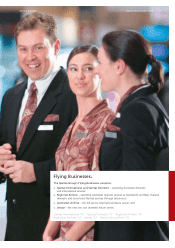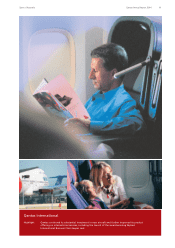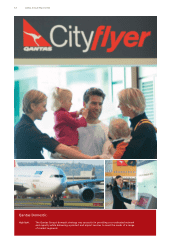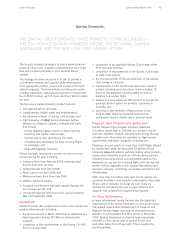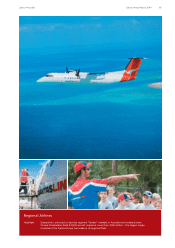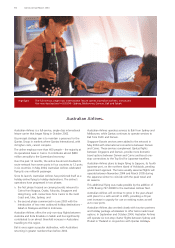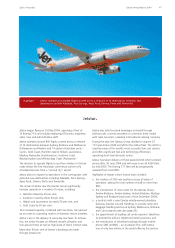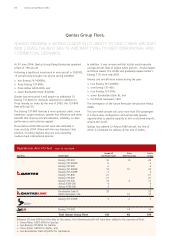Qantas 2004 Annual Report Download - page 12
Download and view the complete annual report
Please find page 12 of the 2004 Qantas annual report below. You can navigate through the pages in the report by either clicking on the pages listed below, or by using the keyword search tool below to find specific information within the annual report.
10 Qantas Annual Report 2004
During the year, Qantas continued to expand its international
operations.
Highlights included:
increasing services to Los Angeles from a low of 25 per
week during the SARS crisis to a record 37 per week –
Qantas now offers more seats to the USA than ever
before;
introducing three direct Brisbane-Los Angeles flights
each week from June 2004, the first time any airline
has offered non-stop scheduled services on this route;
purchasing additional landing and take-off slots at
London’s Heathrow Airport;
announcing an increase in services to London from 21
to 27 per week from 31 October 2004 with three new
Perth-Singapore-London services and three new Sydney-
Hong Kong-London services (with a fourth Sydney-Hong
Kong-London service to be introduced next year);
lifting non-stop Hong Kong services to greater than pre-
SARS levels, including three new Perth-Hong Kong flights
each week, increasing Brisbane-Hong Kong services from
three to four a week and increasing Melbourne-Hong
Kong services from five to seven a week;
increasing services from Australia to Tokyo to 31 flights
per week, including the restoration of Melbourne-Tokyo
services to pre-SARS levels;
introducing non-stop services to Mumbai, three times
a week, from 1 September 2004; and
announcing that Qantas will begin flying to Shanghai
three times a week from December 2004.
In June 2004, Qantas entered into a codeshare partnership
with Air France, offering customers daily services to Paris via
Singapore from November 2004. Under the air services
agreement between Australia and France, Qantas is
restricted to operating only three flights to Paris each week
and this limited schedule made it difficult to operate the
route profitably. Under the new schedule, customers will fly
Qantas from Australia to Singapore and then connect to Air
France flights between Singapore and Paris.
Investment
Qantas continued its substantial investment in new aircraft
(see page 18) and further improved its product offering on
international services.
In September 2003, Qantas launched its new International
Business Class featuring a self-service Business Class bar and
specially-trained, dedicated flight attendants.
Qantas also introduced the celebrated sleeper seat, Skybed.
Skybed is two metres (six feet 6.5 inches) long and offers
maximum comfort, convenience and flexibility for customers
including:
a fixed cocoon-style seat surround to provide maximum
privacy;
extensive seat adjustment controls to ensure maximum
comfort in any position;
a large 10.4 inch (26.4 centimetre) video screen with
multi-channel entertainment; and
a PC power outlet that allows laptops to be plugged in
without the need for adaptor cables.
Skybed has been extremely popular with customers.
It won two prestigious design awards during the year –
an Australian Design Award and a Good Design Award
from the Chicago Athenaeum Museum of Architecture
and Design.
The entire fleet of three-class Boeing 747-400 and
747-400ER aircraft will be flying with Skybed by the end of
calendar 2004 and new Airbus A330-300 aircraft fitted with
Skybed are being progressively added to the international
network.
The upgrading of Business Class was accompanied by
improvements to the First Class offering. These are being
progressively introduced into the Boeing 747-400 and
747-400ER fleet.
Alliances
Qantas continued to maintain a series of strategic alliances
with other airlines to create scale and scope for its
operations, build stronger feeder traffic, improve fleet
utilisation and deliver a better product to customers.
Qantas is a founding member of the oneworld alliance that
features seven other airlines: Aer Lingus, American Airlines,
British Airways, Cathay Pacific, Finnair, Iberia and LAN.
Qantas also continued its separate bilateral alliances with
British Airways, American Airlines, Japan Airlines and Air
Pacific and codeshare arrangements with these airlines as
well as: Aircalin, Air Niugini, Air Tahiti Nui, Air Vanuatu,
Alaska Airlines, Asiana, Cathay Pacific, China Eastern,
EVA Air, Finnair, Gulf Air, LAN, Norfolk Jet Express,
Polynesian Airlines, South African Airways,
Swiss International and Vietnam Airlines
THE QANTAS GROUP’S INTERNATIONAL OPERATIONS, INCLUDING
AUSTRALIAN AIRLINES, ACHIEVED EARNINGS BEFORE INTEREST
AND TAX OF $398.9 MILLION, UP FROM $206.9 MILLION LAST YEAR.
Qantas International


